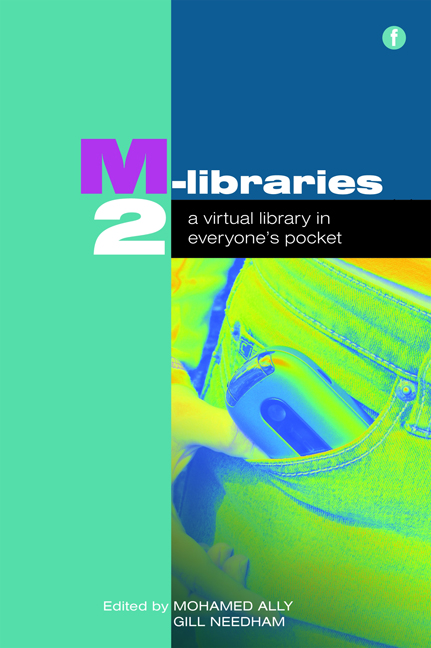Book contents
- Frontmatter
- Contents
- Acknowledgements
- Contributors
- Foreword
- Introduction
- PART 1 M-LIBRARIES: DEVELOPMENTS AROUND THE WORLD
- 1 Where books are few: the role of mobile phones in the developing world
- 2 Mobile technology in Indian libraries
- 3 Mobile technologies and their possibilities for the library, University of the South Pacific (USP)
- 4 M-library in an m-university: changing models in the Open University of Catalonia
- 5 Piloting mobile services at University of Houston Libraries
- PART 2 TECHNOLOGY IN M-LIBRARIES
- PART 3 APPLICATION OF M-LIBRARIES
- PART 4 M-LIBRARIES AND LEARNING
- PART 5 BUILDING THE EVIDENCE BASE FOR M-LIBRARIES
- Conclusion
- Index
2 - Mobile technology in Indian libraries
from PART 1 - M-LIBRARIES: DEVELOPMENTS AROUND THE WORLD
Published online by Cambridge University Press: 08 June 2018
- Frontmatter
- Contents
- Acknowledgements
- Contributors
- Foreword
- Introduction
- PART 1 M-LIBRARIES: DEVELOPMENTS AROUND THE WORLD
- 1 Where books are few: the role of mobile phones in the developing world
- 2 Mobile technology in Indian libraries
- 3 Mobile technologies and their possibilities for the library, University of the South Pacific (USP)
- 4 M-library in an m-university: changing models in the Open University of Catalonia
- 5 Piloting mobile services at University of Houston Libraries
- PART 2 TECHNOLOGY IN M-LIBRARIES
- PART 3 APPLICATION OF M-LIBRARIES
- PART 4 M-LIBRARIES AND LEARNING
- PART 5 BUILDING THE EVIDENCE BASE FOR M-LIBRARIES
- Conclusion
- Index
Summary
Introduction
The total number of mobile phone users has risen to 350 million since the inception of mobile use in the country, and India is one of the most attractive markets for mobile telephone operators and wireless equipment vendors. The Indian government is targeting 500 million telephones, both fixed and wireless, by 2010. The market is growing by about ten million new mobile users per month, and with this pace of growth India will probably be close to 450 million subscribers by the end of 2009. Four factors have driven the growth of the mobile subscriber base in India. These include footprint expansion by existing operators, especially in rural areas, launch of operations by newer operators, issuing of 3G licences – which opens up a new world of data services – and cheaper handsets, which will lower entry barriers even further (Jain, 2008).
Libraries and documentation centres in India are keeping this proliferation in view and have also initiated some mobile learning (mlearning) services. E-learning has been successful, and now m-learning represents the next stage in an ongoing continuum of technology mediation. It will require new digital communication skills, new pedagogies and new practices. It will also foster young people's interest in their mobile phones and other hand-held communications/entertainment devices to deliver exciting and unusual learning experiences and related messages.
M-learning, especially its main delivery system, mobile-phone learning, is under observation, and in coming years will be effectively and extensively used or accepted for learning purposes by either educators or the general public in India. The goal of modern digital libraries in India is to support ‘nomadic’ computing by providing appropriate wireless networking ‘hotspots’ and access to information through mobile devices to support flexible learning space and mobile learning.
The proliferation of mobile technology over the past decade has made librarians face issues that were previously the responsibility of software designers and specialists in the field of human–computer interaction (HCI). In this chapter, we will describe the weaknesses inherent in, and some non-viable factors of, mobile phone learning. We will describe how libraries can combine the technologies of mobile communications with any electronically delivered material to impart support services, and will discuss the new PDA technologies, smart phones and wireless connections available in India. This chapter will also present strategies for delivering educational resources to mobile devices through libraries in India.
- Type
- Chapter
- Information
- M-Libraries 2A virtual library in everyone's pocket, pp. 13 - 26Publisher: FacetPrint publication year: 2010

